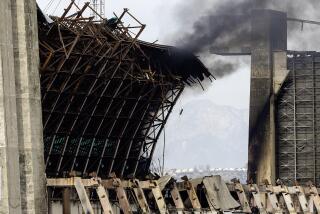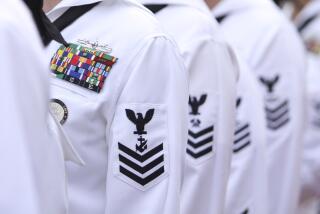Navy Will Continue Its ‘Chaff’ Exercises : Need to Practice Dropping Anti-Radar Fibers Called Essential Despite 2 Foul-ups
- Share via
Despite two recent accidents in which it purportedly disrupted electrical service in San Diego, the Navy plans to continue anti-radar exercises involving the aerial dropping of millions of non-toxic, hair-fine fibers called “chaff,” a spokesman said Wednesday.
Lt. Cmdr. Tom Jurkowsky, a spokesman for Navy air forces in the Pacific, described as “essential” the need to practice dispensing chaff, an aluminum-fiberglass substance that is designed to baffle radar-guided missiles and protect aircraft carrier battle groups.
“It is imperative that we continue to do this to maintain proficiency,” Jurkowsky said. “We really have no choice.”
Utility to Bill Navy Nor has the Navy considered moving its anti-radar exercises to a different site. Naval aircraft routinely dispense chaff over an area of the Pacific Ocean roughly 100 to 300 miles southwest of San Diego. “We’ve practiced out there for years,” Jurkowsky said.
Meanwhile, San Diego Gas & Electric Co. officials said they intend to bill the Navy for the more than 20 customer complaints that SDG&E; received after a three-hour power outage last Thursday. The power company has blamed the outage on the Navy’s chaff.
During that incident, Navy aircraft conducting anti-radar exercises 100 to 190 miles offshore dispensed a 3,000-pound chaff cloud that drifted inland on unexpectedly high winds. The cloud, according to SDG&E;, ionized power equipment and knocked out electricity to 65,000 customers.
The episode cost the power company at least $50,000 in damaged equipment, labor and customer claims, utility officials estimated Wednesday. They had no specific amount for the value of the claims, but many of the customers who complained said their appliances and other electrical devices failed to work after power was restored.
On Tuesday, SDG&E; officials investigating a widespread rash of flickering lights discovered that a Navy KC-135 airplane taking off from Miramar Naval Air Station about 1:30 p.m. had inadvertently dropped several packages of chaff on a power substation near the airfield.
Navy officials have acknowledged that their chaff drifted over the city last Thursday and that Tuesday’s unrelated incident resulted in chaff landing on SDG&E; equipment. However, they have not accepted financial responsibility for either accident, pending the outcome of their investigation--which they have indicated may take a month or more.
Representatives of the Navy and SDG&E; sat down formally for the first time Wednesday to discuss the two incidents. The meeting, which Jurkowsky said was “totally amicable,” is expected to be the first in a series.
Afterward, Donald E. Felsinger, SDG&E; vice president for customer service, said company officials don’t expect the Navy to discontinue chaff exercises. However, he said, SDG&E; does hope that it will be notified before future anti-radar exercises--a request that Jurkowsky said may well be honored.
Such notification could help crews respond more quickly to power outages should chaff once again ionize the company’s equipment, Felsinger said.
“We realize the Navy has a job to do, but we want them to understand that we have a job as well,” he noted.
Felsinger said SDG&E; is studying its power supply system to see if modifications would prevent future chaff-related outages. He declined to detail the specifics of such a plan.
More to Read
Sign up for Essential California
The most important California stories and recommendations in your inbox every morning.
You may occasionally receive promotional content from the Los Angeles Times.













